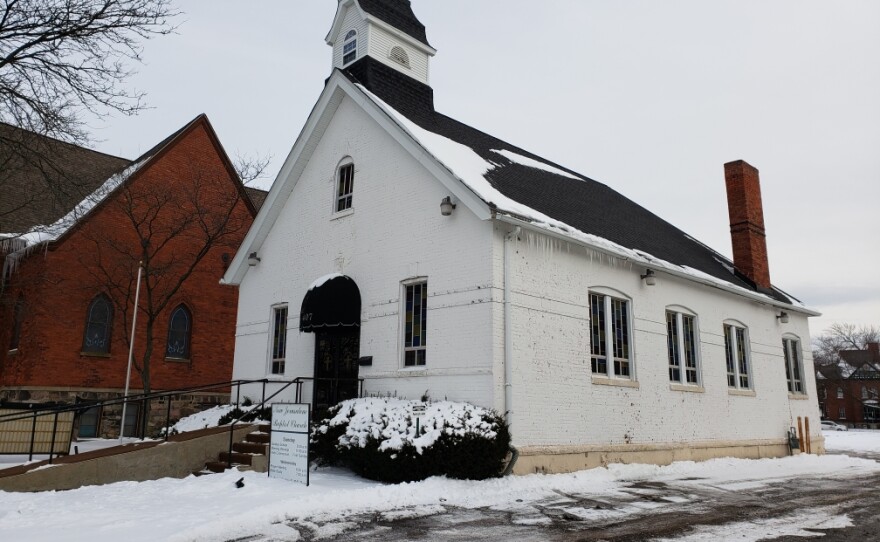Did you know that Ypsilanti’s New Jerusalem Baptist Church was originally built as a school for African-American students? The First Ward School closed in 1919 after more than 50 years of operating in the era of “separate but equal.” WEMU’s Jorge Avellan explores the history of the school, its connection to a landmark segregation case in Michigan, and where we stand on that issue 100 years later.
"If you were a black child in Ypsilanti anywhere between 1864 and 1919, you went to this school."
The classic, one-room, brick schoolhouse, sits in the shadow of the former Brown Chapel A.M.E. Church at the intersection of South Adams and Buffalo on Ypsilanti’s historic south side. Snow on the ground blends in with the white exterior of the building. Standing outside in 30-degree weather, we are joined by local historian Matt Siegfried.
"The school began during the period of the Civil War when many black families arrived to Ypsilanti in the 1850’s because of the Underground Railroad. Black students were able to go to Ypsilanti schools but they had to sit in the last two rows of the class. And people did not escape from slavery and fight to get to freedom to have their children sit in the back two rows of class," said Siegfried.
That led to a demand for black teachers and principals and prompted the school district to establish the all-black First Ward School. In the early 1900's, about 10% of Ypsilanti’s school-aged children were African-American, and many of them attended First Ward.
Jorge: "What were the students taught?"
Matt: "Just like you would imagine in any other school, writing, reading, arithmetic. This school also housed sort of a library for the community and the school was also a place where adults could learn as well. So, there were adult classes here in the evening for learning how to read and write and arithmetic and things like that. So the school was pretty rudimentary but gave you enough to get you through life, a working life."
Historian Matt Siegfried notes that thousands of students received a good education at the all-Black school. They include Dr. George Cleveland Hall, who became a pioneer surgeon, and Fred Anderson, who went on to become an acclaimed classical and opera singer.
It wasn’t an easy road. After 55 years of little to no substantial maintenance, the building’s leaky roof, lack of heat, and issues with sewage led the community to request their children be allowed to attend the better maintained schools intended for white students. The district refused, and black leaders such as Herman Kersey and Walter Robbins took action.
"Eventually, there was a court case on Michigan Civil Rights laws, the United States didn’t have civil rights laws at that point for which you could go to federal courts. And under Judge Sample in Washtenaw County Court in 1919, in the spring of 1919, this school was ordered to be closed because it was segregated. So, the school board and the city eventually decided that having students go to school on the basis of race was wrong, but they would have those students go to school on the basis of where they lived," said Siegfried.
100 years later, segregation is still an issue. That’s according to Dr. Benjamin Edmondson, the former Superintendent of the Ypsilanti Community Schools.
"You absolutely see it in the county, you see it in the county schools. It’s pretty clear what communities are segregated," said Edmondson.
Data obtained from the National Council for Educational Statistics appears to support this view. For example, 89% of families with an income less than $100,000 in Ypsilanti Community Schools send their children to public schools compared to less than half of those with household incomes over $200,000. Research from the Civil Rights Project notes a "striking rise in double segregation by race and poverty for African American and Latino students who are concentrated in schools that rarely attain the successful outcomes typical of middle class schools with largely white and Asian student populations."
Dr. Edmondson is now the executive vice president for HighScope School in Ypsilanti. It’s a nonprofit designed to support efforts to improve early childhood education. It is his observation that some school districts still aren’t as welcoming as they should be.
"I don’t want to put them out there, but I’ve worked with some of them. Where we know that there’s only a limited amount of kids of color that are there or that school of choice is not allowed in that particular school. We don’t have school of choice here, but on the other side of town we have school of choice," said Edmondson.
Dr. Edmondson says school districts must have the will to change if they want to end racial segregation.
"Are they going to give up power to take lesser? And that’s how they see it. Am I going to give up opportunities for my kids for these other kids? That’s kind of the mindset. Even though people see themselves as quote Liberal, I think that starts to seep into the bones, yeah. As though the other people don’t have anything to bring. They might not bring the economics but they bring something that’s going to help a community out," said Edmondson.
Non-commercial, fact based reporting is made possible by your financial support. Make your donation to WEMU today to keep your community NPR station thriving.
Like 89.1 WEMU on Facebook and follow us on Twitter
— Jorge Avellan is a reporter for 89.1 WEMU News. Contact him at 734.487.3363 or email him javellan@emich.edu












